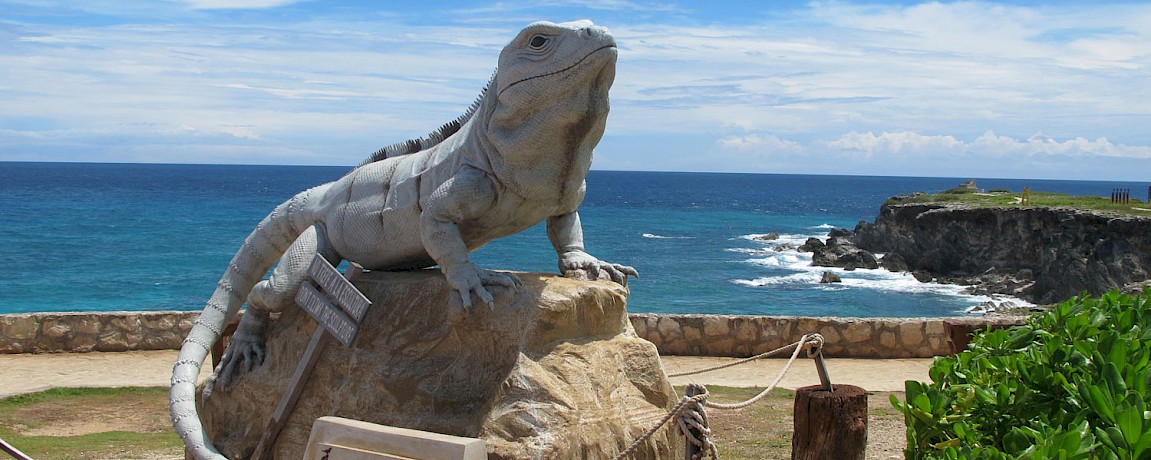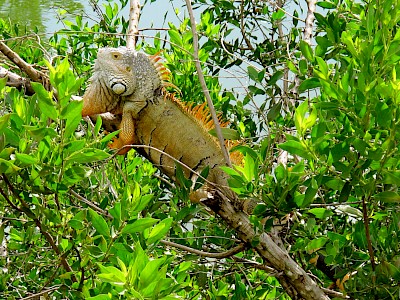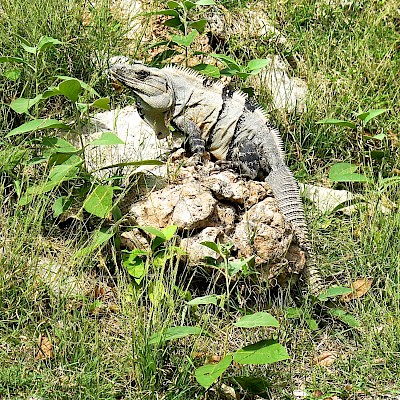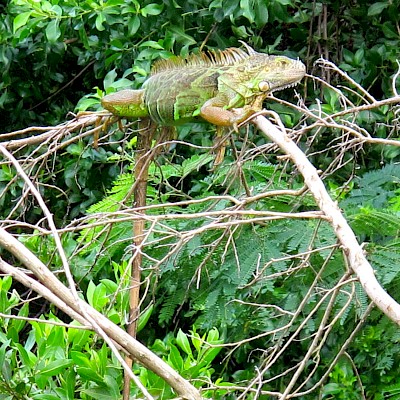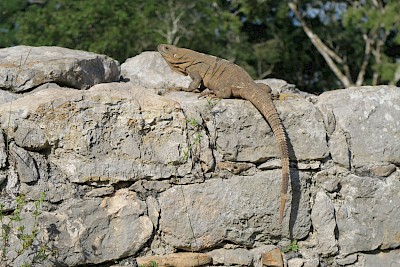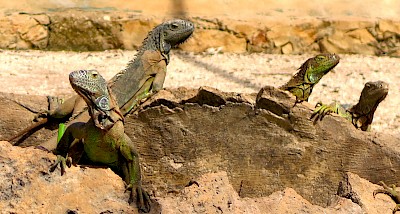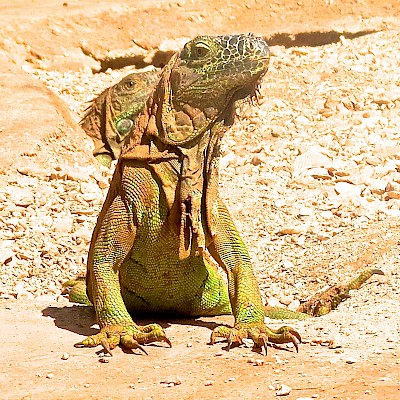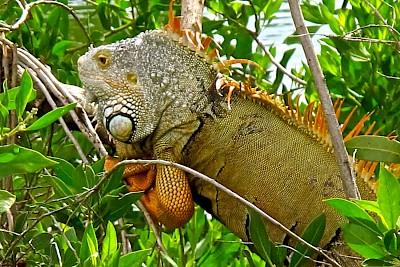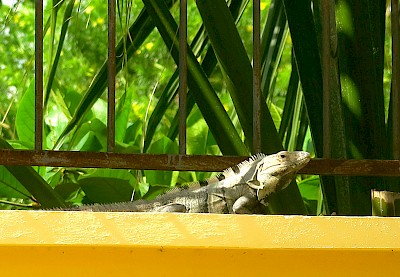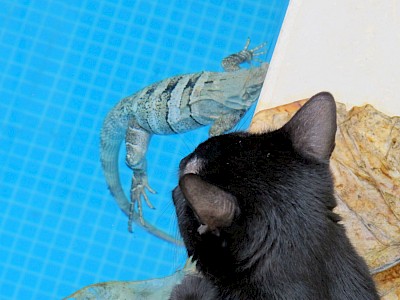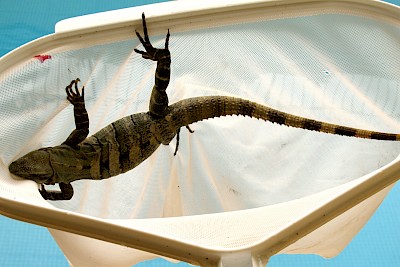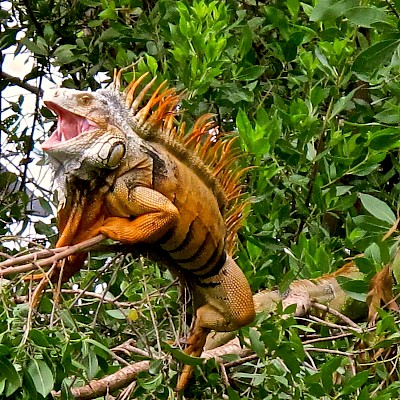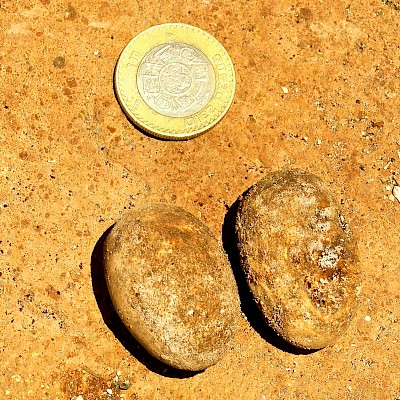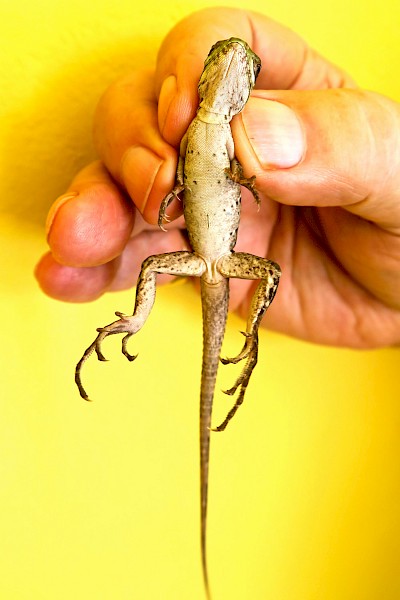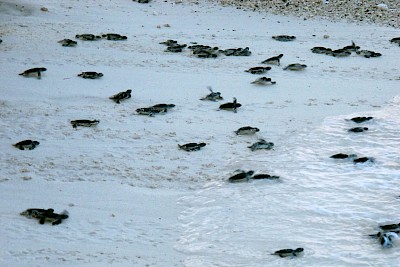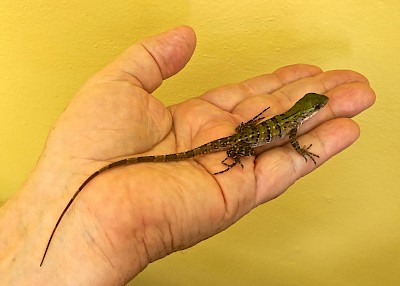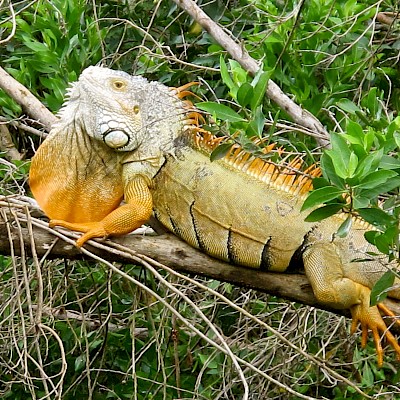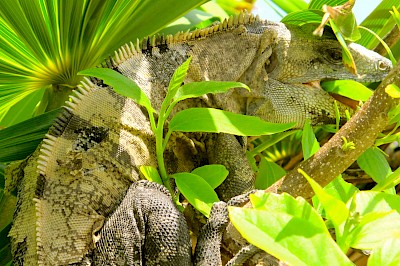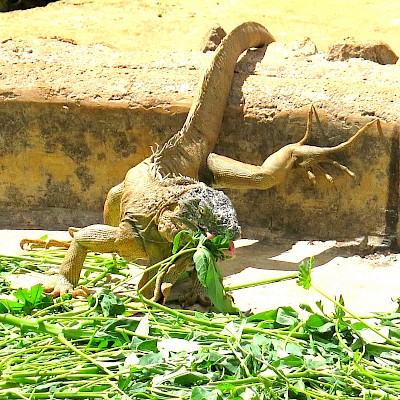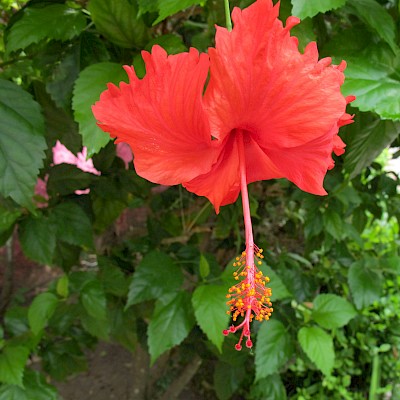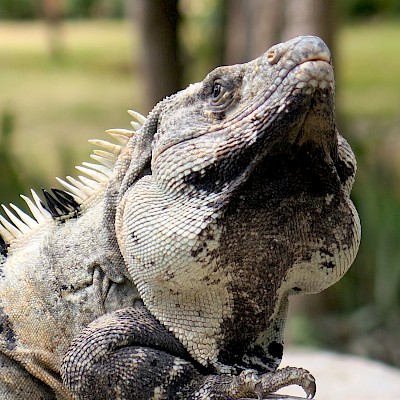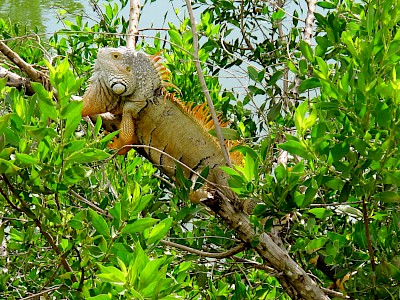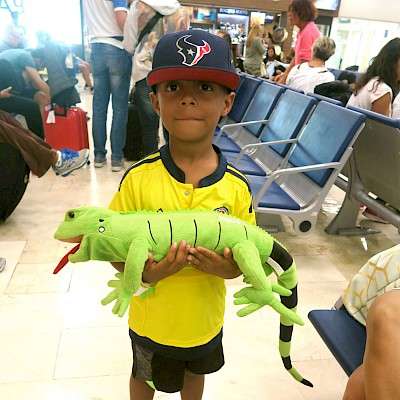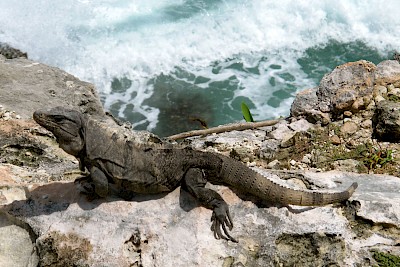Iguanas of Yucatan, Part III
Editor's Note: Here is Part III of our three part series about those "squirrels of the jungle", iguanas. Byron Augustin, the author, completes our education about the habits and habitats of iguanas, as well as other facts that make them so fascinating. Enjoy! (If you haven't yet read Part One, you can do so here, Part Two is here.)
In Part III of our series on iguanas we will examine the range and habitat of the two major species of iguanas that live on the Yucatan Peninsula, as well as several other interesting aspects about their lives. Read below to learn more about their social and communication traits as well as mating, reproduction, diet, digestion, defense and predators. We hope that after readers have finished the series, they will feel more knowledgeable about these noble reptiles that are part of our ecosystem in both rural and urban locations in the Yucatan, and will afford them more respect.
Iguana Living Conditions
Iguanas like warm temperatures. They are cold-blooded reptiles that cannot regulate their own temperature and therefore their existence dictates living in a tropical environment with daytime temperatures ranging from 70 to 100 degrees Fahrenheit. If you think gringos and canucks complain about a norte (cold front from the north) assaulting the Yucatan Peninsula in January or February, you can only imagine what the iguanas are thinking!
Fortunately, all of the Yucatan Peninsula including the states of Campeche, Yucatan, and Quintana Roo, are located in the tropics. In fact, the mid-line latitude for the Yucatan Peninsula is 18.8 degrees north latitude. In Merida, the average daily high temperature is 85 degrees Fahrenheit in the cool season and 94 degrees Fahrenheit in the hot season, well within the range suited to iguanas.
Iguanas like lowland environments, as opposed to hilly and mountainous regions where temperatures drop with increases in elevation. They could not have selected a better place than the Yucatan, where no elevation reaches above 700 feet and Merida sits at approximately 30 feet above sea level.
The two major species of iguanas inhabiting the Yucatan are the Black Spiney-tailed Iguana and the Green Iguana. Both species are found in all three Yucatan states, but the Black Spiney–tailed Iguanas far exceed the Green Iguanas in both numbers and distribution.
The Black Spiney-tailed Iguanas are terrestrial (they live on the ground), and prefer a rocky surface, scrub forest and drier environment. They are at home in the hundreds of Maya ruins scattered across the Yucatan, as well as the colonial rock walls that still exist in many rural and urban environments.
The Yucatan Peninsula is almost completely composed of limestone, which has been used for walls for centuries. The limestone also appears as massive surface rocks that extrude from the thin, poor soils. As the minerals in the limestone oxidize and mold discolors the surfaces, it creates a perfect camouflage for this species of iguana.
The Green Iguanas are arboreal (they live in trees), prefer the lowland topography, but also want to be near rivers, lakes, and lagoons. That preference exempts most of the Yucatan Peninsula. If you drive from Cancun to Merida on the toll road (cuota), which is nearly 200 miles, you will not cross one river or see a single lake or lagoon. The green iguanas of the Yucatan can be found near the border with Guatemala, along the Caribbean coast from Puerto Morelos to Mahahual, on the island of Cozumel, and at Banco Chinchorro, the largest coral atoll in North America. The easiest place to see green iguanas is at the aforementioned VallaZoo in Valladolid.
Iguanas Are People Too!
Scientists have conducted research that helps us understand the social interactions of iguanas. If you have spent any time in the Yucatan, you know that you seldom see more than one or two iguanas at the same time. They appear to be non-social and lacking in any group dynamics. But thinking that would be wrong. Iguanas are territorial and within a territory, generalizations can be made regarding social structure.
There is one alpha male who is dominant over a group of other adult males, females, and juveniles. The group is referred to in biology as a 'lounge'... isn't that just perfect? Males are termed 'bulls', females are referred to as 'cows' and sexually immature individuals of either sex are 'juveniles'.
There is a significant difference in the personality of an adult female and a male iguana. Generally, females are submissive, timid, less aggressive and less adventuresome. Females seldom fight among themselves, and if they do, it is usually over scarce nesting sites. The males are more aggressive, assertive, domineering, narcissistic and short-tempered, especially during the mating season. Vicious combat between two males can take place over territorial claims and perspective mating partners.
Females seem to be attracted to the biggest males but might possibly move to a different territory and mate with a different male the following year. Long-term relationships may or may not last. The dominant adult males have no attachment to any female other than the sex act and will probably successfully breed 10 to 12 females each year. After copulation, it is adios! See you next year. Maybe.
Iguana Family Values... Not
The concept of family does not exist. Males engage in sex, not parenting. They do not have a clue if a young iguana is a family member or not. Neither do the females, who after laying their eggs may guard the nest for a few days to make sure another female does not dig up her eggs, but then she leaves.
The greatest amount of social interaction among iguanas occurs immediately after the eggs hatch. The young iguanas are called 'hatchlings'. With no mother or father to provide care, security, or emotional support, the youngsters band together in groups and engage in a close relationship. They emerge from the nest and visually survey their surroundings for predator danger. If all is clear, they leave the nest, accept an individual leader, and engage in ceremonies of licking each other, body and chin rubbing, tail waving and nipping at abdomens and thighs in a playful manner. They sleep together, frequently touching each other, and strengthening the bond between them.
If they survive, the group may stay together for up to a year. As a human, it seems this must be one of the best periods of their lives because of the mutual emotional support.
What Did You Say?
Humans use several forms of communication including verbal, body language, electronic, and chemical. Verbal communication, speaking and listening, dominates how we communicate with each other. Iguanas use almost no audio communication. They do not oink, moo, baa, meow, or woof. The only audio communication they use is hissing. They will hiss out of fear or as a defensive warning.
The majority of an iguana’s communication is done visually. If you are familiar with lizards in general, you probably know that they engage in head bobbing. Head bobbing can be used as a welcoming gesture or a threatening technique against competing males and predators. Dominant adult males use head bobbing to attract females during the mating season.
When I lived in Texas, we had a number of chameleons that made their home in our potted patio plants. They would perch on the end of a stem, inflate a sack under their neck and bob their heads, announcing that the plant was their territory. I admired their chutzpah, but it usually ended with my cat negating their territorial claims.
As urban sprawl spreads on to undeveloped land, iguanas may be absorbed into the changing habitat. We have an iguana that likes to stroll along the top of our privacy wall on the back patio. He is located eight feet off the ground, so he does not pay much attention to me. If I move toward him, he sometimes stops and gives me a few quick bobs indicating, in his mind, that the wall is his territory. I told him the other day, if he was claiming the wall, he should get it painted. I'm still waiting.
Iguanas and House Pets
House pets can come into conflict with the urban iguanas because both of them feel that the territory is theirs. This can end in disaster, as one of our readers pointed out after reading Part I. An iguana killed Kara’s beloved cat of twenty years. My cat had better luck. He spotted an iguana between a foot and a foot and one-half long, basking by a potted plant next to the pool. I watched him quietly sneak up on the oblivious reptile and give him a hard stroke with his front leg, knocking him into the swimming pool. It was February and the temperature of the pool water was probably in the low 60s. The iguana went from a skin temperature of maybe 85 or 90 degrees to shockingly cold water. It totally immobilized him and left him in a defenseless condition, which my cat used to his advantage by whapping him on the head and generally tormenting him. Guess who had to extract him and move him to a nearby vacant lot?
More Than Head Bobbing
Other means of visual communication include dewlap extension, tail wiggling or thrashing, raising the spikes along their backs, standing tall on all four legs, inflating their jowls, and jaw-gaping. The jaw gaping is often accompanied with audio hissing and presents a fairly impressive scene. They can also attempt to intimidate, by “staring you down.” If you establish eye contact and lock-on the iguana’s eyes in a staring contest, he may become nervous and flee. If you are trying to get closer for a better photo, do not look him directly in the eye, move slowly, and stop occasionally before proceeding to a spot for a good photo.
Iguanas engage in chemical communication by marking their territory with secretions from their femoral glands. The secretions are composed of non-volatile proteins and a variety of smaller volatile and non-volatile fats. As the iguana drags its hind legs over branches, rocks, and other surface features it leaves its chemical mark. Other iguanas can recognize each other’s scent by extending their tongues to pick up scent molecules. When they retract their tongues, the scent transfers to a scent detection organ in the mouth known as the Jacobson organ. Since each iguana’s scent is distinct, it allows dominant males to detect intruders that enter their territory. Nothing is said, nothing is observed, but communication has occurred nevertheless.
'Tis the Season
Mating among both major species of iguanas in the Yucatan is strongly seasonal. The mating season for an individual male lasts approximately 30 days. Females are receptive to males for a week to ten days. There are plenty of willing candidates to meet her needs during this brief period. Some males will begin contact with females in November, while the stragglers will finish a little later. The start of the mating season is aligned specifically with the beginning of the dry season and is normally finished in 45 days. The fertilized eggs are laid about 60 to 65 days after mating has taken place. The eggs hatch in 90 to 110 days, just in time for the beginning of the rainy season. The rain spurs new growth of tender, young leaves for the hungry hatchlings. Timing is everything in the reproductive cycle of iguanas.
Normally, iguanas are not particularly active, sleeping more than a cat and basking quietly in the sun at mid-day. When the sun goes down, so do the iguanas. However, during mating season, the rules change. Dominant adult males downsize their personal territory so that they can secure their female partners from want-to-be Casanovas. The alpha males control the best territories and display themselves by dropping their dewlaps, standing tall, raising their back spikes, puffing up and in general engaging in narcissistic behavior for the girls. The color of their skin darkens and most green iguanas turns bright orange, making them more visible to a prospective female target. They eat less during the mating season and will attempt to fertilize the eggs of 10 to 15 females. It is a difficult job, but hey, someone has to do it! They can rest for the remaining eleven months of the year.
The effort the males make seems to pay off, as the females move to the territories where the biggest males are displaying themselves. Personality, compassion, sensitive expressions and actions do not play a role in the selection process. In the end, their choice of a mate is strongly related to the physical characteristics of her partner. This seems a little shallow, but it seems to work. There are still plenty of iguanas. Females seem to be looking for a male with good DNA that will produce hatchlings with the best chance of survival. One herpetologist suggested that females select a male that has outlived, outfought, and out courted his competitors.
Buried Alive
After mating, the female waits approximately two months before digging a nest to lay her eggs. The black spiney-tailed iguanas that live on the ground have to search for good nesting sites since pockets of soil are small in the thin, rocky environment of the Yucatan. The female green iguanas who live in trees near rivers, lakes and lagoons are more likely to find loose, sandy soils to dig their nests in. It is one of the few times the female green iguanas will leave the trees they inhabit.
The length of time necessary for successful incubation is primarily dependent on the depth of the egg placement, exposure to direct sunlight, and soil temperatures. Usually after three months the eggs begin to hatch. The number of eggs that are in the nest, range from as few as ten up to 70. The total deposit of a female’s eggs is termed a clutch and the size of the clutch is dependent mostly on the size and sexual maturity of the female. An average size clutch contains 30 to 35 eggs. The eggs have a flexible, leathery-textured shell and are about one to one and one-half inches long and two inches in circumference. As the baby iguana develops it absorbs its necessary nutrients from the yolk.
When it is time for the hatchlings to escape the leathery shell, they tear a hole in the skin of the egg with a single tooth called a coruncle. Having served its purpose, the tooth falls out a short time later. At some point, the hatchlings realize that they have literally been buried alive. Pure instinct leads them to begin digging an escape tunnel to exit the nest. It takes them about a week to reach the surface. At that point, the hatchlings are six to nine inches long and weigh between three or four ounces. In less than three years, they can weigh two pounds.
Biological researchers Burghardt, Green, and Rand spent five hundred hours observing new green iguana hatchlings and described the extraordinary social patterns of the youngsters. The young iguanas stayed in groups, bonded physically and emotionally and after a short time left the nest to move into low shrubs and bushes before moving to the forest canopy as they matured. Sadly, their vulnerability to predators at such a young age means that half of the group will only live an entire month and a mere 2.6 percent of these wonderful, precocious hatchlings live more than one year.
What's For Dinner?
The choices of food that animals eat lead to a simple generalization. Meat eaters are termed carnivores, plant eaters are herbivores, and those that consume both meat and plants are known as omnivores. The green iguanas are mostly herbivores and consume very little animal protein in their diets. The black Spiney-Tailed iguanas may eat a few insects, small fish, rodents, and bird eggs, but those do not make up a significant part of their diet. Most days, both species of Yucatan iguanas would be classified as herbivores. The iguana's digestive system is not designed to digest animal protein. They prefer to eat plant leaves, buds, tender stems, flowers and fruit. In fact, during the rainy season when there is a plentiful supply of young, soft leaves, those leaves will make up three-quarters of their diet. Since leaves make up such a large component of their diet, iguanas are sometimes referred to as folivores, or leaf eaters.
Herpetologists have suggested that iguanas require a 2:1 ratio of calcium to phosphorus in their diet. Unfortunately, the iguana does not have the opportunity to read the ingredients label on the back of the leaf. Iguanas simply eat a variety of plants that keep them healthy. During a grazing sequence they may select four or five different plant species that compose their meal. The next day their selections may include a completely different selection of plant species. They are willing to travel longer distances to consume the plants they like. Scientific studies have indicated that different groups of iguanas will make different choices. In one study, the group members (the lounge) ate 26 out of 95 plant species that were available, while another group consumed 24 out of the 54 plant species they had to choose from.
In their food preferences, iguanas are no different than we are. When we pass down a buffet line, we ignore some dishes and load up on others. Late at night when we go to the refrigerator to graze on the choices that are available, selection are made. Availability plays a large role in dietary selection. If there are apples on the table, you might eat one. But if pears are all that are available, you'll probably have a pear.
The changes of the seasons also give iguanas different choices. Urban iguanas love compost piles where they can dig around for ripe bananas and papaya that have been tossed out. You may also note that a hungry iguana has mutilated your hibiscus and bougainvillea flowers. Captive, “pet” iguanas frequently die within the first year of captivity because their owners do not take the time to learn how to feed their iguana properly. A National Geographic article points out that iguanas are high-maintenance pets and because they are usually not properly cared for, most do not live more than a year. (Better not to cage them, right? But that is a different discussion...)
Cuisinarts of the Jungle
Iguanas eat almost every day. It is critical for their survival because of their complex digestive tract. As with most things, there are exceptions. Dominant adult males fast occasionally during the mating season, as they are preoccupied with other matters. Females carrying a large number of eggs will not eat every day as the time for laying their eggs draws near. Carrying 30, 40, or even 70 eggs does not permit much space in the stomach cavity for food. Almost all iguanas lose their appetite in cool or cold temperatures and cold has a negative impact on the speed of their digestion. If temperatures are between 75 and 95 degrees Fahrenheit, both appetite and digestion will be stimulated properly.
Iguanas consume mostly plant material that is high in cellulose. They do not produce cellulase to break down that cellulose, making it difficult to provide the nutrients necessary for good health. To counter this problem, they absolutely must have a bacteria called microflora in their gut system to break down what they eat. Even new hatchlings need this micorflora as they begin to eat vegetation. In the process of digging out of their nest they end up consuming dirt that contains microflora they need to begin life. Later, they begin to eat the feces of adult iguanas that contain microflora until they reach the necessary level. Dirt and poop are not normally on the menu, but these hatchlings instinctively know what must be done for them to reach maturity. Once sufficient microflora is obtained, renewal does not seem to be necessary.
The key to eating happily ever after when the microflora is operating properly is temperature. The iguana must maintain its body temperatures at high levels throughout the year. Basking in the sun provides the heat their bodies need. This explains why you frequently see them stretched out on a rock or branch soaking up the rays. Fortunately, even when air temperatures drop in the winter dry season, there are a lot of days with clear skies and sunshine.
On Guard!
Life in the wild means animals need to protect themselves. Iguanas use their defensive skills in two situations. First, dominant adult males need to defend their territory and their harem, which involves intra-species defense. Females do not engage in territorial defense, with the exception of a few who hang around their nesting site to make sure another female does not dig a nest in her spot and destroy her eggs.
Adult males frequently establish or defend their alpha male position. There are always young gunslingers that are prepared to challenge the top iguana. A majority of these conflicts are mock fights and no physical contact occurs. The combatants engage in head bobbing, dewlap extension, erection of dorsal spikes, puffing up their jowls, pushing up their bodies on all four legs, whipping their tails, and jaw gaping when they open their mouths wide and hiss. The idea is to make yourself as big and intimidating as possible. The iguana with the biggest physical appearance normally wins the fake fights and the challenger slinks away shamed for his concession.
Occasionally, the challenger takes the fight to his opponent and a nasty, real fight develops. They scratch, bite, and wrestle to gain a superior position for protecting themselves. It can be a dirty fight, no holds barred and anything goes.
Secondly, iguanas must defend against predators. The best defense against a predator is to avoid them completely, of course, and both males and females use these useful defense mechanisms. Iguanas have excellent eyesight and they can spot a predator at a great distance. The next step is to slide into the tree foliage or a crevice in the rocks and become absolutely still. Their natural colors camouflage their location in the trees and rocks.
Green iguanas use their parietal eye on the top of their head to detect shadows of birds of prey and escape by plunging 30 or 40 feet to the water below their branch. They either swim away or settle to the bottom where they can hold their breath for up to 30 minutes. If running from a predator becomes necessary, they possess excellent speed to assist in their escape. If the predator grabs the tail of the fleeing iguana it is capable of detaching part of its tail, leaving the predator holding the tail in confusion.
A Dangerous World
From the moment a female iguana lays her eggs, the survival of the future hatchlings is tenuous. Snakes, small mammals, and humans find the nests and consume the eggs. If the nests remain secure and the incubation is successful, the hatchlings will dig their way to the surface and face the brave new world. Long term survival of these cute, gregarious, little lizards is unlikely, as they have no parental protection.
Snakes, birds of prey and small mammals pose the biggest threat in early life. Hawks and owls consider them a delicacy and swoop down to snatch them off a branch, twig, or rock. Snakes move quietly through the low vegetation and catch them resting or sleeping. Foxes, ocelots and other small cats also pose a danger. Unscrupulous humans hunt them and sell them in the illegal pet trade. Although the majority of iguanas sold in pet shops are raised on legal farms, the demand is so great that the supply is supplemented by captured wild iguanas. Between 2001 and 2008, it has been estimated that more than five million iguanas were sold in international pet markets.
Adult iguanas continue to be threatened by predators. Large birds of prey attack from the sky, mammals attack on the land, pythons and large snakes attack in the trees and on the ground, and crocodiles chase them in the water. Constant vigilance is the story of their lives.
Humans prove to be a challenging adversary. The iguanas are hunted ruthlessly for food. In Nicaragua, the females are especially vulnerable when they are laying their eggs. Egg laying frequently falls during Lent when devout Catholics do not eat meat. Strangely, the hierarchy of the church declared iguanas non-meat centuries in the past, so they are fair game at the very time of the year when growing and protecting their population is the most important. Humans also capture adult iguanas and use them as live bait to catch crocodiles. They skin them and use their hides for exotic leather products.
In my opinion, the most despicable predatory act of humans is capturing and caging iguanas as pets. What is it about man that makes it okay to take another species and condemn it to life in a small cage for his or her personal enjoyment? While some individuals truly love their iggys and are compassionate and treat them well, a large number of owners do not.
When a child in a pet store becomes infatuated with the darling, outgoing, little iguana, they do not think about the fact that it will grow into a four or five foot aggressive reptile that requires high maintenance to keep alive. The child is not nearly as infatuated as it was at the time of purchase and loses interest. Many parents also lose interest in the iguana as a pet. The average iguana held in captivity seldom lives more than a year. Or, the iguana is released secretly in the night where it eventually dies because of a habitat ill suited to its survival. If the environment is a tropical habitat with proper temperatures, the pets may live, breed, and become a real threat to the ecological balance of the area, as they have in Puerto Rico.
Another horror for iguanas is being captured and brought to restaurants, bars, hotels, and other tourist attractions, placed in cages, and displayed to people who tease them, and try to feed them food that can kill them. Compliments should be extended to the Municipality of Isla Mujeres, which has developed a viewing area for free living, black spiney-tailed iguanas near the south end of the island. It is easy to find as they have constructed the largest iguana in the world to identify the location of a large group of iguanas that live in the cliffs overlooking the turquoise-blue waters of the Caribbean Sea. They congregate on the surface in between the giant iguana that I have taxonomically named (Iguanus concretous) and the water’s edge. If you are a visitor and need to find an iguana, that seems like a good place to start. If you live in the Yucatan, you know that you'll probably see one in your back yard eventually. Start a compost pile, and you are sure to attract one or two!
Yucatan iguanas are part of the ecological treasures that make it special to live here in the Yucatan. They should be able to bask in the sun and enjoy the environment as much as we do. A little respect goes a long way towards allowing us to share this special place we call home with this very special species.
Note: Remember that by placing your curser on the photos and clicking, the photo will enlarge.




